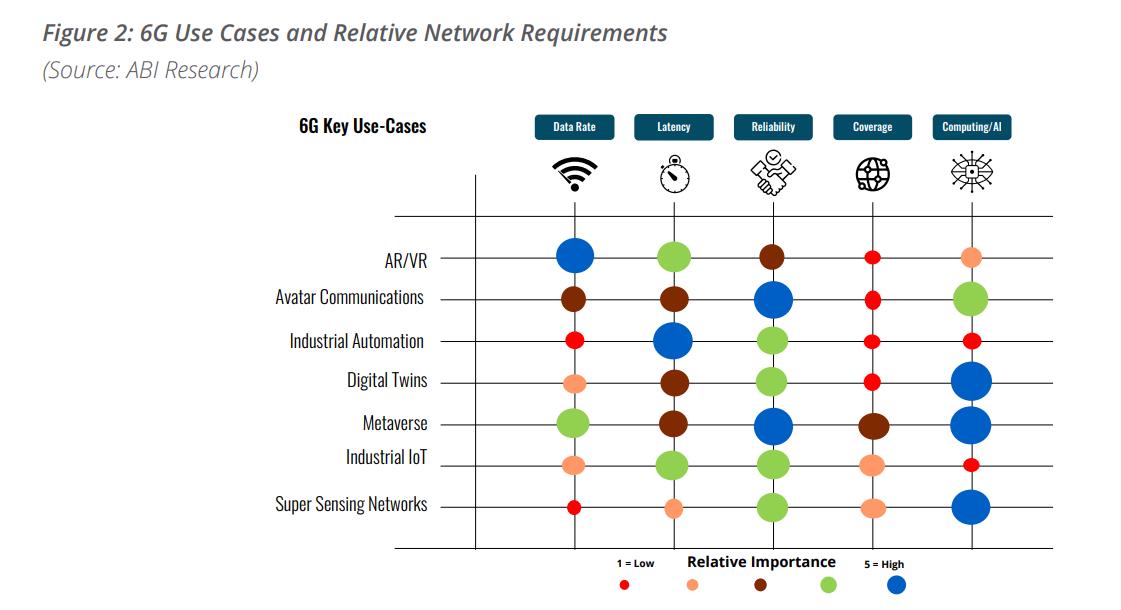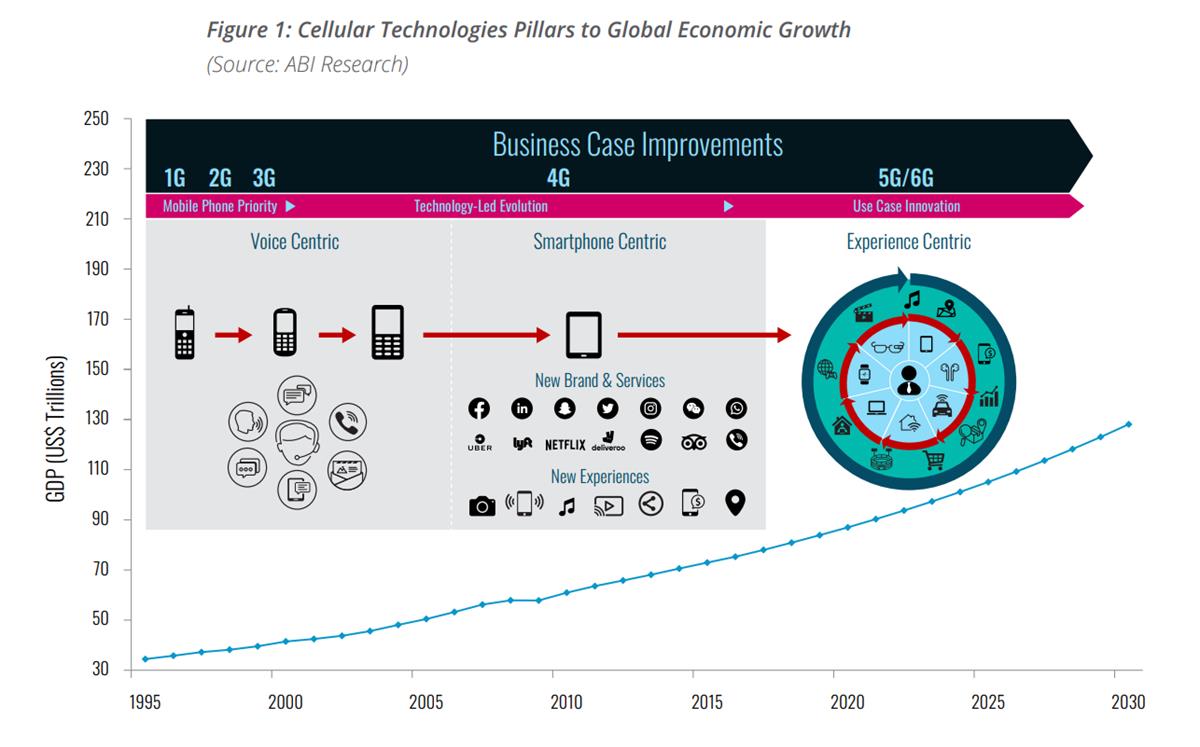
READ MORE: 6G: The Network of Technology Convergence (InterDigital)
Cellular technology evolution across multiple generations has consistently sustained global economic growth — and 6G will be no exception, according to InterDigital.
The R&D house, which owns patents in 4G and 5G mobile communications standards, is busy staking claims for the next evolution, 6G, which could begin being rolled out by the end of the decade.
“Now that 5G commercial launches are rolling out, targeting both consumer and enterprise applications, the industry is already preparing itself for 6G, the next generation of telecommunications networks,” InterDigital outlines in a white paper, “6G: The Network of Technology Convergence,” co-authored by ABI Research.

The paper is an attempt to frame the use case for 6G and, presumably, to encourage investment in its development by states and telco communications providers.
It is envisioning 6G as a platform able to accommodate innovations coming from multiple disciplines, including connectivity, computing, AI, sensor networks, and virtualization.
Read more: 6G and the Possibility of a Haptic, Holographic Internet
Read more: 6G Mobile Network Begins to Take Shape with 7G Already in the Wings
One plank of the 6G platform will feature AI and computing as integral parts to network architecture, not just add-on optional features.

To put this into a context, InterDigital states that only 1% of data generated by connected humans, apps, and machines are processed, analyzed, and used today to make better and informed decisions.
“There is a huge opportunity to refine and extract information from every single data point generated in the process in a trustworthy manner. This is where 6G will be useful. 6G will be the key enabler for massive data processing compared to 4G and 5G.”
Implementing AI as a native function of the network will enable 6G to become the first-generation network to promote large-scale deployment of self-optimized and automated networks.
“The realization of the metaverse will rely on a widespread deployment of interconnected sensory networks, including cameras, photodiodes, inertial sensors, time-of-flight sensors, ambient sensors, and biometric sensors.”
— InterDigital
NAVIGATING THE METAVERSE:
The metaverse may be a wild frontier, but here at NAB Amplify we’ve got you covered! Hand-selected from our archives, here are some of the essential insights you’ll need to expand your knowledge base and confidently explore the new horizons ahead:
- What Is the Metaverse and Why Should You Care?
- Avatar to Web3: An A-Z Compendium of the Metaverse
- The Metaverse is Coming To Get You. Is That a Bad Thing?
- Don’t Expect the Metaverse to Happen Overnight
- A Framework for the Metaverse from Hardware to Hollywood and Everything in Between
There are clues to how this will be implemented in plans for 5G releases. For example, device-to-device (D2D) communications (called sidelink enhancements) specified under 5G Release 18 and above, lead to improved “accuracy, power efficiency, and integrity” of positioning used for Simultaneous Location and Mapping (SLAM) applications.
These sidelink specifications will continue to evolve under 6G to enable devices “to establish their own ad hoc network and communicate with devices belonging to that network without using public radio access resources as an intermediary.”
Under 6G, the full D2D communications capabilities will “enable a massive amount of traffic to be offloaded as devices can communicate directly and share data with other devices in their proximity without the need for public network intermediation. Not only this, but D2D will enable proximity services to be offered with premium quality in line with their expected ultra-reliability and low latency requirements.”

It is this “distributed intelligence” that will enable information to be delivered between machines, infrastructures, and virtual objects in real time, more reliably, and in a safer way, InterDigital believes.
In turn, this will supercharge the immersive real-time nature of our online experiences. In short, 6G delivers on the vision of the metaverse.
“6G promises to blur the boundaries between the virtual and real spaces,” the white paper forecasts. “The technology will enable the extension of the end-user experience beyond physical reality. Under this vision, users will be able to visualize, monitor, operate, or even simulate the reality of physical objects in a digital world without any physical constraints.”
“There is a huge opportunity to refine and extract information from every single data point generated in the process in a trustworthy manner. This is where 6G will be useful. 6G will be the key enabler for massive data processing compared to 4G and 5G.”
— InterDigital
InterDigital talks primarily about applications outside of Media & Entertainment. Greater GDP gains will be derived from simulating real-world solutions powered by 6G since, for example, this will lead to more accurate results and lower hardware repair costs by predicting maintenance needs and scheduling. Simulations could also lower the cost of new projects by eliminating the need for unwanted physical trials and proof-of-concept designs, the company writes.
“The realization of the metaverse will rely on a widespread deployment of interconnected sensory networks, including cameras, photodiodes, inertial sensors, time-of-flight sensors, ambient sensors, and biometric sensors.”
Further, 6G will come with a huge capacity — up to one TBps per base-station — ultra-low latency below one millisecond, reliability up to ten times “for certain mission critical services,” and dynamic slicing.

The network should be able to accommodate the requirements of different device types, from simple sensors to smart devices, and different application types belonging to either the physical or the virtual domains.
However, for this vision to materialize, a significant number of new innovations need to take place in the domains of security, end to end orchestration and automation among others.
Moreover, the 6G supply chain needs to retain its global status and remain free of geopolitical influences to allow 6G to accelerate and create a critical mass of enterprise use cases,” InterDigital warns.
It also urges telecom operators and content providers to align towards 5G and 6G network capabilities. This, InterDigital says, “will further illustrate the capabilities of 6G, and by the time the 6G standard is ready, the market will have matured for several use cases to be commercialized.”


